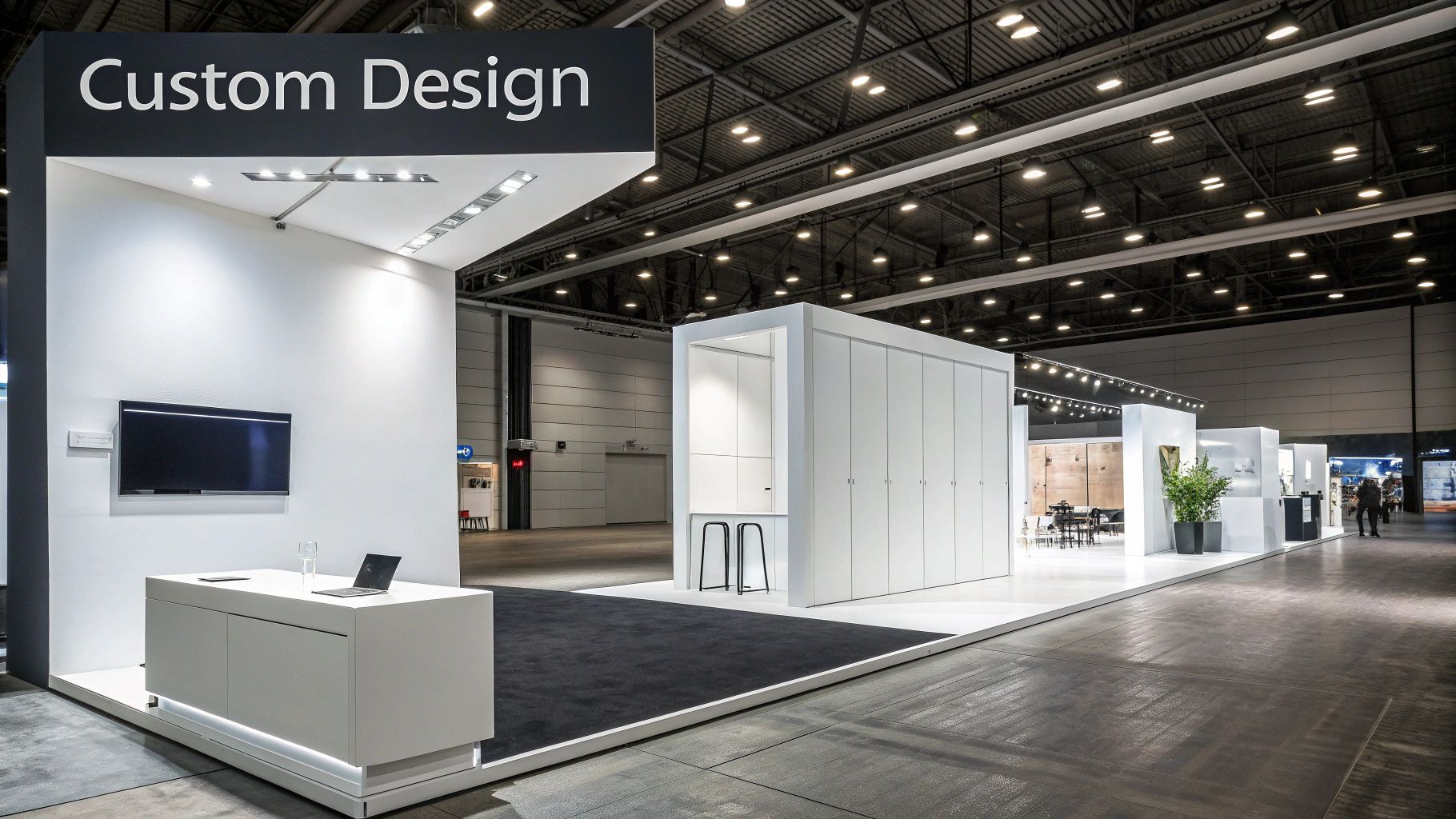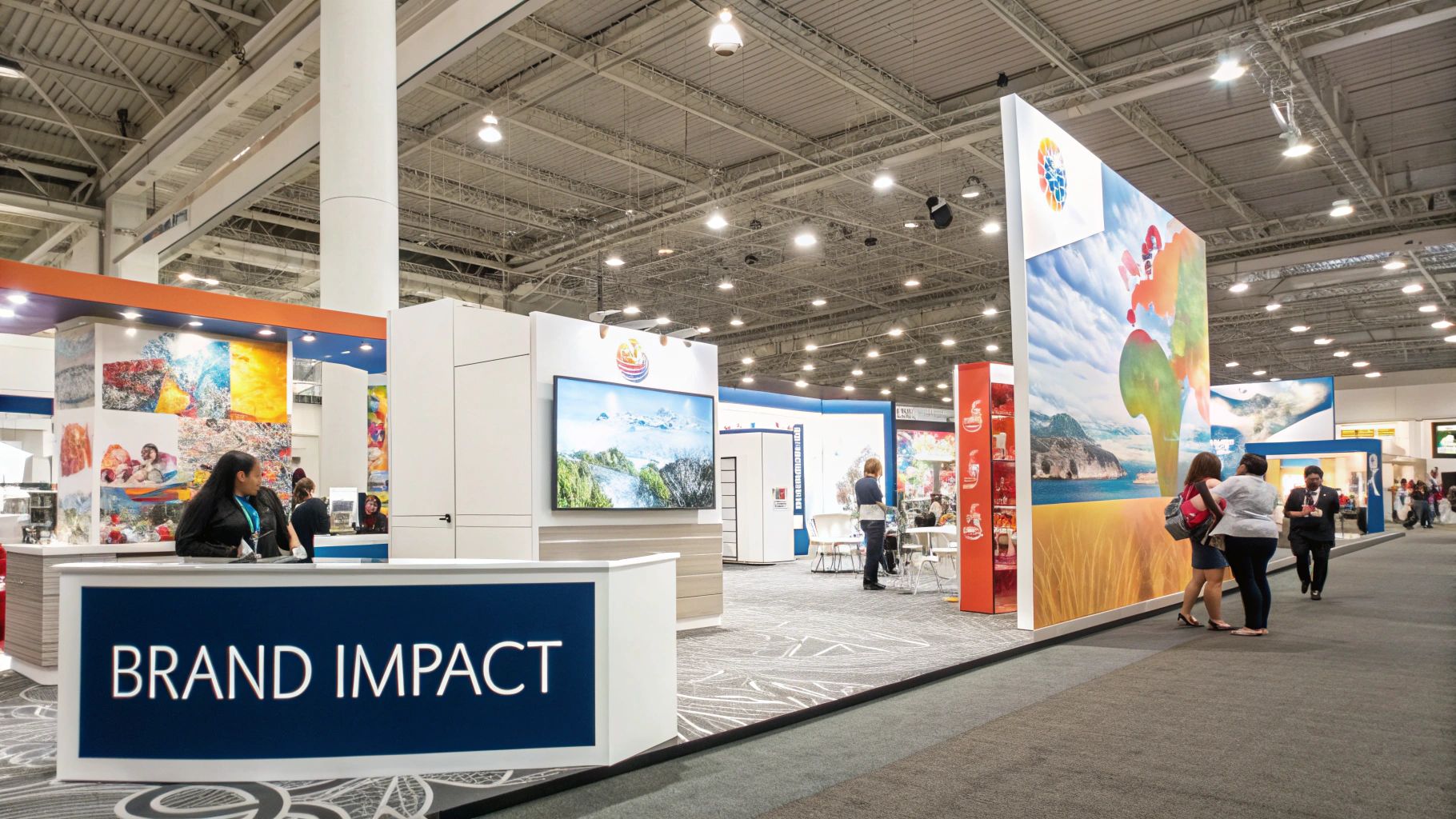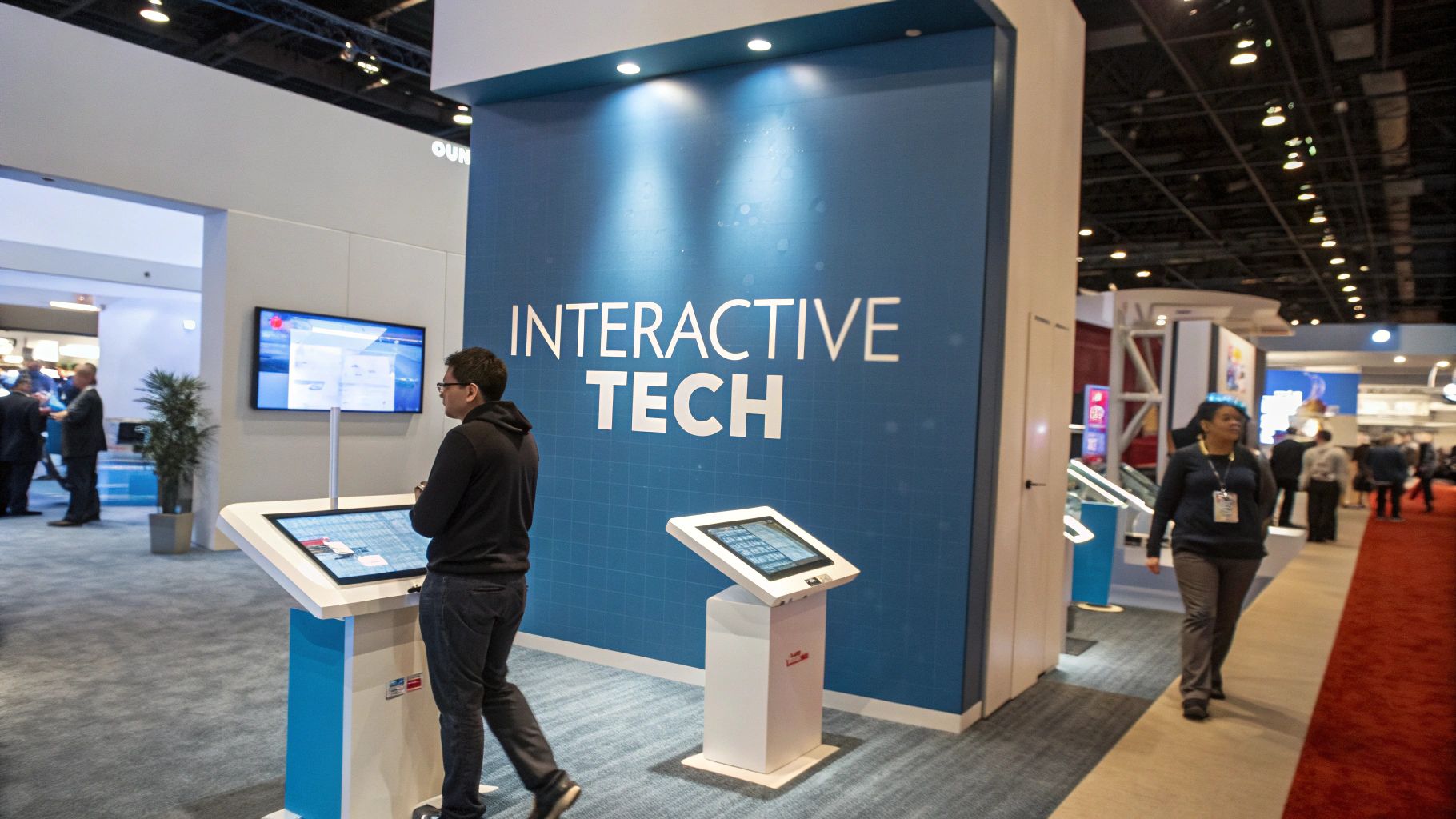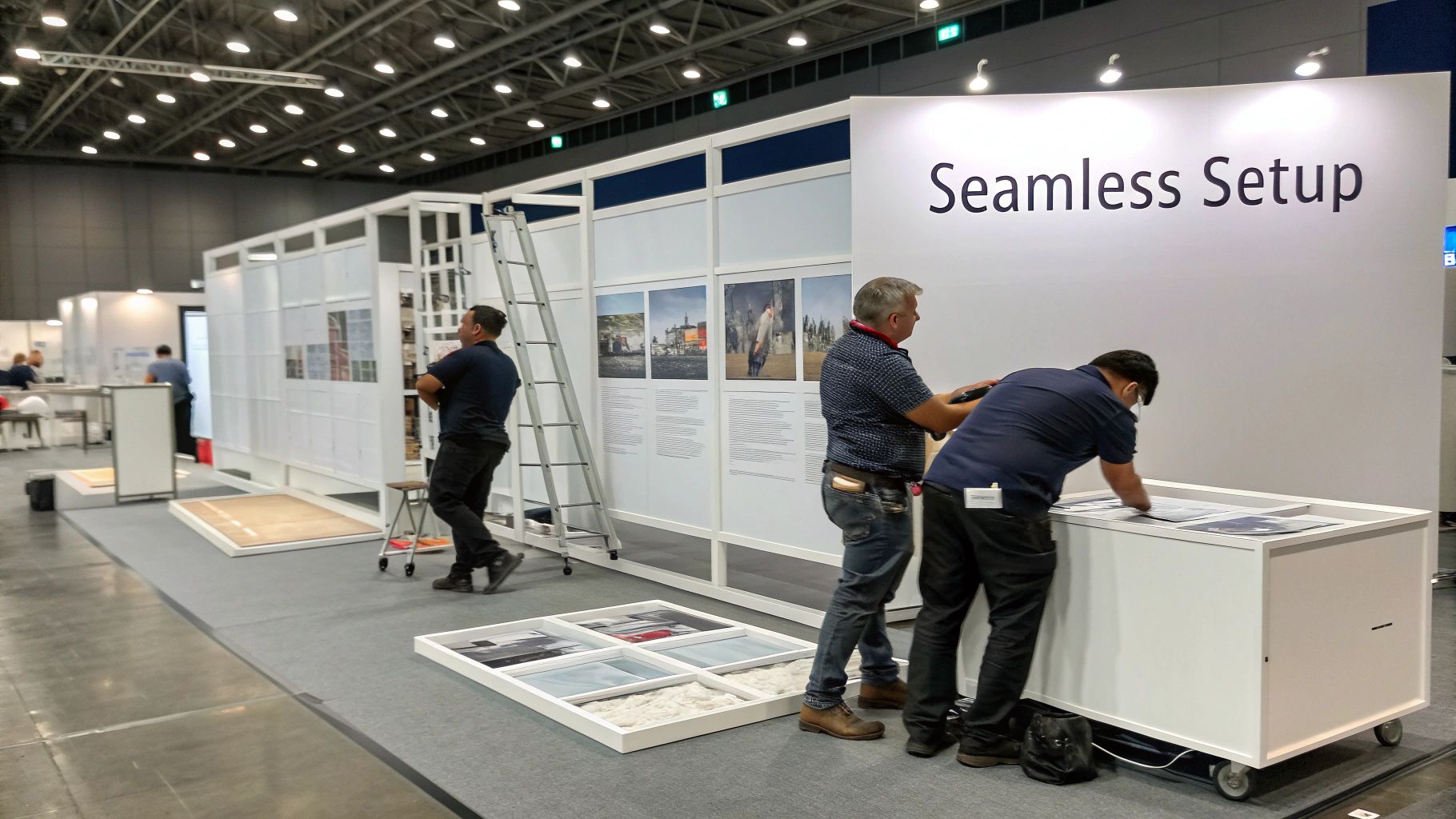Transform Your Exhibit with Custom Trade Show Booth Designs
Why Custom Trade Show Booths Transform Brand Perception
In the competitive environment of trade shows, a standard booth can easily get lost in the crowd. A custom trade show booth, however, presents a powerful way to shape how attendees perceive your brand. Instead of just displaying products, you're creating an immersive experience that resonates with your target audience. This shift from product display to brand storytelling is a key reason why leading companies invest in personalized exhibition spaces.
These customized environments offer a unique advantage: authentically communicating your brand's values. For example, a tech company might use sleek, minimalist design to convey innovation. A sustainable food brand might incorporate natural materials to emphasize their eco-conscious values. This targeted approach allows you to differentiate yourself in a crowded exhibition hall.
Custom booths also leverage the psychological impact of environment. Think about how you feel in a well-designed retail store versus a disorganized discount outlet. The same principles apply to trade show booths. A thoughtfully designed space can create a sense of trust, professionalism, and excitement, fostering meaningful connections with attendees. This positive first impression can significantly influence purchasing decisions and leave a lasting impact.

Furthermore, the growth of the exhibitions market fuels the demand for custom booths. The global exhibitions market was valued at $44,150.1 million in 2024. It is projected to reach $66,749.9 million by 2033, growing at a CAGR of 4.7%. This expansion signifies a growing need for innovative ways to stand out, with businesses actively seeking effective methods to showcase their offerings. Explore this topic further. This trend underscores the rising importance of B2B and B2C exhibitions, and the crucial role custom booths play in capturing attention and providing a memorable experience.
The Power of a Personalized Experience
Custom trade show booths offer a strategic advantage by allowing for personalized experiences. These tailored interactions move beyond superficial engagement, creating genuine connections that resonate long after the event. This personalized approach helps transform casual visitors into qualified leads and fosters valuable relationships.
-
Targeted Messaging: Custom booths allow for clear, concise messaging tailored to the target audience at the trade show.
-
Interactive Elements: Incorporating interactive technology, demonstrations, and personalized activities keeps attendees engaged and reinforces key brand messages.
-
Private Meeting Spaces: Dedicated areas within the booth facilitate focused discussions and create a more intimate setting for building rapport with potential clients.
By carefully crafting a custom booth experience, businesses can cultivate deeper connections with their target audience, leaving a lasting positive impression. This focused approach elevates brand perception and contributes to measurable business results.
Crafting Custom Trade Show Booths That Convert Visitors

A visually appealing custom trade show booth is essential for attracting attendees. However, its true value lies in its ability to convert those visitors into qualified leads and, ultimately, paying customers. This transformation relies on strategically balancing visual appeal with a practical and functional layout. Imagine a booth with eye-catching graphics but a confusing layout. Visitors may be initially drawn in by the aesthetics but quickly become disoriented and fail to grasp your core message.
This is where thoughtful booth design becomes crucial. Creating an intuitive traffic flow within your booth is paramount for effectively guiding visitors through your brand story. Think of your booth as a carefully curated journey, leading attendees through key messages and product demonstrations. This controlled flow maximizes engagement and ensures your message resonates with your target audience.
Designing for Engagement and Conversion
Leading companies are increasingly incorporating interactive technologies, like touchscreens and virtual reality, into their booth designs to create more immersive and memorable experiences. These technologies offer valuable touchpoints, encouraging deeper engagement with your brand. Dedicated demonstration zones provide a space for potential customers to experience your products firsthand. In addition, private meeting areas offer a more intimate setting for in-depth discussions with key decision-makers.
Trade shows represent invaluable platforms for businesses to connect with potential customers. A significant 81% of trade show attendees possess purchasing authority, with 46% representing executive-level management. This highlights the importance of a well-designed custom booth that captures the attention of and resonates with these high-level decision-makers. Find more detailed statistics here. A strategically designed custom trade show booth can significantly improve lead generation and drive tangible business results.
Key Elements of High-Converting Booth Designs
The following table highlights the key elements that contribute to a high-converting booth design. It provides a comparison of how each design element contributes to visitor engagement and, ultimately, drives conversions.
| Design Element | Purpose | Impact on Engagement | Impact on Conversion |
|---|---|---|---|
| Clear Branding | Reinforces brand identity | Increased recognition | Stronger brand association |
| Interactive Displays | Encourages active participation | Higher dwell time | More qualified leads |
| Demonstration Zones | Showcases product functionality | Practical experience | Increased purchase intent |
| Private Meeting Areas | Facilitates in-depth conversations | Personalized interaction | Higher conversion rates |
| Traffic Flow | Guides visitors through the booth | Improved information intake | More meaningful interactions |
By incorporating these elements, businesses can create an experiential environment that captivates attendees and leaves a lasting impression. This strategy goes beyond simply attracting attention; it fosters meaningful interactions that continue to influence purchasing decisions long after the event has concluded. Furthermore, a well-designed booth effectively communicates your brand message, reinforcing its value proposition and setting you apart from the competition. This creates a competitive advantage, attracts more qualified leads, and contributes to measurable business growth.
Measuring Real ROI From Your Custom Trade Show Booth

Trade show success hinges on more than just the number of leads collected. While leads are important, they represent only one aspect of a successful event. Savvy exhibitors understand that measuring Return on Investment (ROI) is crucial. They prioritize meaningful engagement metrics that translate into tangible sales. This data-driven approach allows for informed decisions and continual refinement of your trade show strategy.
Accurate ROI measurement starts with clearly defined objectives, established before the show begins. These objectives should be SMART: Specific, Measurable, Achievable, Relevant, and Time-bound. For example, instead of “generate more leads,” a SMART objective would be “generate 50 qualified leads for product X within the first two days of the show.” This provides a concrete benchmark to gauge performance.
Efficient data collection is also vital. Consider leveraging lead retrieval systems, conducting post-show surveys, or tracking interactions through digital platforms like Eventbrite. Integrating technology seamlessly within your booth design, like those offered by Pilot Exhibits, can streamline data capture and analysis. This data offers invaluable insights into attendee behavior and identifies areas for improvement. Without consistent and organized data collection, evaluating your investment's effectiveness becomes mere guesswork.
Custom trade show booths play a crucial role in both brand awareness and lead generation. The U.S. trade show market is projected to reach $15.8 billion in 2025, surpassing pre-pandemic levels. This growth underscores the increasing importance of booths designed to effectively attract attendees. Nearly half of exhibitors recognize the power of visually appealing displays in drawing potential customers. Discover more insights about trade shows. Custom designs optimize booth efficacy and contribute to favorable business outcomes.
Post-Show Analysis and Key Performance Indicators
Post-show analysis is crucial. It provides the opportunity to evaluate what strategies were effective and where improvements can be made. Analyzing collected data against pre-defined objectives offers actionable insights for refining future exhibition strategies.
Different industries may prioritize different Key Performance Indicators (KPIs). A software company might focus on demo requests and trial sign-ups, while a manufacturer might track leads converted into sales meetings. However, some universal KPIs apply across sectors:
-
Return on Investment (ROI): The overall financial return from the trade show.
-
Cost Per Lead (CPL): The cost associated with acquiring each lead.
-
Conversion Rate: The percentage of leads that become customers.
-
Brand Awareness: The increase in brand recognition after the event.
-
Customer Engagement: Attendee interaction levels, measured through surveys, demos, or other engagement metrics.
Consistently tracking and analyzing these KPIs enables continuous refinement of your custom trade show booth strategy. This data-driven approach ensures informed decisions and maximizes the return on your investment, solidifying your brand's market presence.
Smart Budgeting for Your Custom Trade Show Booth

Creating a captivating custom trade show booth doesn't have to break the bank. Strategic planning and smart budgeting are essential for maximizing your return on investment, regardless of your budget. This involves carefully distributing resources across all aspects of your booth, from the initial design and materials to the final fabrication and integration of technology. Visualize your budget as a pie chart, where each slice represents a key booth element. Careful consideration of each slice's proportion ensures you get the most impact for your investment.
Understanding Cost Drivers and Allocation
Several factors influence the overall cost of a custom trade show booth. Design complexity is a major one. Intricate designs often require higher design fees and specialized fabrication. Your choice of materials also impacts the budget. High-end materials, like custom-milled aluminum or exotic wood finishes, naturally come with a higher price tag. Integrating technology, such as interactive displays or immersive virtual reality experiences, can also significantly affect the final cost.
However, there are ways to manage expenses without sacrificing the quality of your booth. Consider sourcing materials directly from suppliers to cut down on intermediary costs. You can also explore modular design options, offering flexibility and the opportunity to reuse components for future trade shows. Partnering with experienced booth designers who are well-versed in cost-effective fabrication techniques can also make a considerable difference. They can provide valuable insights into design choices and material selection that minimize costs without compromising visual appeal and functionality.
Cost-Saving Strategies and Avoiding Pitfalls
Optimizing your trade show booth budget is more than just finding the cheapest options. It's about making informed decisions that strike a balance between cost and overall impact. For instance, investing in high-quality, reusable booth components might have a higher initial cost, but this can translate into substantial long-term savings. Reusing elements eliminates the need to purchase new materials for every show. This approach fosters more sustainable and cost-effective exhibition practices.
Common budgeting mistakes often involve overlooking hidden costs. These can include transportation, drayage, storage fees, and the cost of on-site labor for booth installation and dismantling. Failing to account for these expenses can result in unforeseen budget overruns. Careful planning and open communication with your exhibition partners are crucial to avoiding these unpleasant surprises.
Exploring Ownership vs. Rental Options and Amortization
Deciding whether to own or rent a custom trade show booth depends on several factors. Ownership offers greater control over branding and customization but entails responsibilities such as storage and maintenance. Renting provides more flexibility and can be a cost-effective solution for businesses that exhibit infrequently or are testing new booth concepts.
Amortizing the cost of your booth across multiple shows is a valuable budgeting strategy. This involves spreading the initial investment over the projected lifespan of the booth, allowing you to accurately calculate the cost per show. This long-term financial perspective helps justify the initial investment and gives you a clearer understanding of your overall return.
Custom Trade Show Booth Investment Breakdown
The following table provides a general overview of the costs associated with different types of trade show booths. Remember that these figures are estimates, and the final cost will depend on your specific design, materials, and chosen features. Working with a company specializing in premium, modular exhibition displays, like Pilot Exhibits, can help you find tailored solutions optimized for both visual impact and cost-effectiveness.
| Booth Type | Size Range | Typical Cost Range | Key Features | Best For |
|---|---|---|---|---|
| Inline Booth | 10x10 | $5,000 - $15,000 | Backwall, graphics, basic lighting | Smaller businesses, first-time exhibitors |
| Corner Booth | 10x10, 10x20 | $8,000 - $20,000 | Two open sides, enhanced visibility | Businesses seeking increased exposure |
| Island Booth | 20x20+ | $20,000 - $100,000+ | Four open sides, maximum visibility, complex design | Established brands, large product showcases |
| Portable Display | Varies | $1,000 - $5,000 | Lightweight, easy to transport | Small budgets, frequent exhibitors, smaller spaces |
By understanding the costs associated with different booth types, planning strategically, and collaborating with experienced professionals, you can create a compelling and effective custom trade show booth without overspending.
Partnering With Custom Trade Show Booth Designers
A captivating custom trade show booth starts with a solid partnership between your brand and a skilled designer. Finding the right design partner is crucial for transforming your vision into a successful exhibition. This collaboration involves more than just selecting a designer with an attractive portfolio. It requires a deep understanding of your brand's identity, business goals, and target audience. Think of it like choosing an architect for your dream home: you need someone who understands your lifestyle, preferences, and budget to create a space that truly reflects you.
Evaluating Potential Design Partners
When evaluating potential designers, consider more than just their past projects. While a portfolio provides valuable insights, also consider these essential factors:
-
Experience in Your Industry: A designer familiar with your industry understands the nuances of your target audience and can create a booth tailored to their interests.
-
Communication Style: Open communication is essential. Choose a designer who actively listens, provides constructive feedback, and keeps you informed.
-
Project Management Capabilities: A well-organized designer will keep the project on schedule and within budget, from the initial concept to the final installation.
Collaborative Vision and Effective Communication
Effective communication is the foundation of a successful design partnership. Clearly articulate your brand’s message, target audience, and desired outcomes for the trade show. When budgeting for your custom booth, remember to factor in the ongoing website maintenance cost crucial for long-term business growth. This proactive approach clarifies expectations from the start, enabling the designer to create a booth that perfectly aligns with your vision.
Provide the designer with comprehensive brand guidelines, marketing materials, and any relevant information about your target audience. This ensures the booth design accurately reflects your brand identity and resonates with your audience. Consider providing examples of booths you admire, highlighting specific design elements you’d like to incorporate. This visual inspiration offers a tangible starting point.
Project Timeline and Feedback Cycles
From initial concept to final installation, a custom trade show booth project involves several key stages:
-
Initial Consultation: Discuss your vision, budget, and objectives with your chosen designer.
-
Concept Development: The designer presents initial design proposals based on your input.
-
Design Refinement: Feedback cycles and revisions are undertaken to finalize the design.
-
Fabrication: The booth components are constructed according to the approved design.
-
Installation: On-site setup and final preparations are completed before the trade show.
Throughout the project, provide regular and constructive feedback. Clearly communicate any changes or modifications, ensuring the final product meets your expectations. This collaborative approach keeps the project on track and ensures the final booth design accurately reflects your vision. A successful custom trade show booth is the result of a strong partnership built on clear communication, mutual respect, and a shared commitment to achieving your exhibition goals.
Next-Generation Custom Trade Show Booth Innovations
The trade show environment is dynamic, and forward-thinking brands are leveraging innovation to stand out. This exploration delves into the latest advancements in custom trade show booths, from augmented reality and interactive technologies to sustainable materials and adaptable designs. These developments are transforming the entire booth experience.
Integrating Cutting-Edge Technology
Imagine stepping into a booth and experiencing a product demonstration through augmented reality (AR). Augmented reality overlays digital information onto the real world, creating interactive and engaging experiences for attendees. Think trying on clothes virtually or exploring intricate machinery without the physical object.
Interactive digital displays are also evolving beyond static graphics. Touchscreens, interactive kiosks, and personalized content delivery systems offer dynamic engagement. These tools empower visitors to actively explore products, access in-depth information, and tailor their experience. This personalized approach can greatly enhance lead generation.
Sustainable and Modular Designs
Sustainability is a core value for modern businesses. Custom trade show booths are increasingly incorporating sustainable materials and practices. Exhibitors are embracing eco-conscious designs by using recycled and recyclable materials, minimizing construction waste, and opting for energy-efficient lighting. This commitment not only reduces environmental impact but also strengthens a brand's image and resonates with environmentally aware customers.
Modular booth designs offer both flexibility and cost savings. These booths are constructed from reusable components, allowing for easy reconfiguration for different show layouts and sizes. This adaptability eliminates the need for new booth construction for every show, saving money and minimizing waste. Modular booths also simplify transportation and storage, streamlining logistics and reducing expenses.
Data-Driven Personalization and Hybrid Experiences
Data is instrumental in personalizing the visitor experience. By gathering data on attendee behavior, preferences, and interests, exhibitors can tailor interactions within the booth. Imagine a display recommending products based on a scanned badge or a personalized presentation delivered through a kiosk. This data-driven approach fosters stronger connections with attendees and improves lead conversion.
Hybrid experiences, blending physical and digital elements, extend a booth's reach beyond the show floor. Live streaming events, hosting virtual tours, and maintaining online engagement after the show creates a more comprehensive brand experience. This multi-platform approach maximizes reach and extends engagement, allowing connection with individuals unable to attend in person.
By embracing these innovations, brands are not only enhancing their trade show presence but also shaping the future of exhibition marketing. These advancements create more engaging, personalized, and effective experiences for attendees, leading to stronger brand connections and maximizing ROI. Ready to transform your trade show presence? Learn more about premium, modular displays at Pilot Exhibits.





